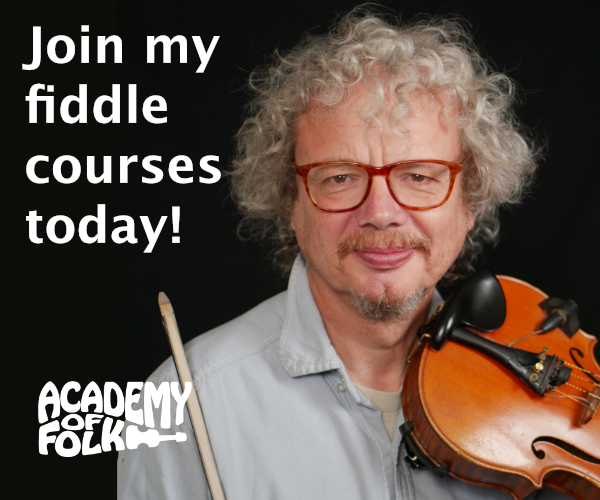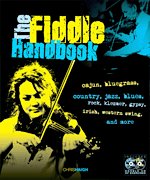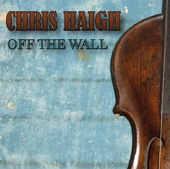
MENU TO FIDDLE STYLES:
Scottish Fiddle
PART ONE ; The History of Scottish Fiddle Music; PART TWO ; Regional fiddle styles in Scotland; PART THREE ; the music-tune types, modes, bowing and ornamentation; PART FOUR ; Contemporary Scottish Fiddle
3.Scottish Fiddle music; tune types, bowing, ornamentation and modes
Scotland has a distinctive repertoire including a number of different types of tune. Many of these tune types are shared with neighbouring England and Ireland, whilst some are uniquely Scottish.
The Strathspey developed in Scotland, the first being written around 1749. They were originally called strathspey reels. They are a similar tempo to reels, and can be used for the same dances, but have a distinctive phrasing based on two kinds of dotted rhythm, often referred to as the Scotch Snap. Some strathspeys are designed not for dancing but for listening, and are played at a much slower tempo (they are known, surprisingly, as slow strathspeys). The name suggests that these tunes either originated in, or became associated with, the area around the strath, or valley, of the river Spey in the Highlands. Strathspeys are normally only 16 bars long; two 8 bar sections without repeats. Strathspeys often form part of a set of tunes, ending up with a reel.
Among the most popular strathspeys are The Laird ‘o Drumblair, The Bonnie Lass o’ Bon Accord, Iron Man, Athol Brose and King George 1V . The first three of these were all compositions by "The Strathspey King", James Scott Skinner .
Similar to the strathspey but brisker and with with more of a 2/4 marching feel is the schottiche.
Reels are widespread in England and Ireland, but have a particular place in Scottish dancing, where the reel is a specific dance figure. Scott Skinner states in his “Guide to Bowing” that reels should be played briskly, like a well oiled wheel; “crisp and birly like a weel-gaun wheelie”. Reels in Ireland are often played with a swinging rhythm, but in Scotland they are usually played even (with all the quavers the same length).
Famous Scottish reels include the Fairy Dance, The Drunken Piper, Roxburgh Castle, De'il among the Tailors, High Road to Linton, Athll Braes, Jenny Dang the Weaver, and Speed the Plough.
A Scots Measure is closely related to a reel, but a little closer to a march. It is played slightly solower, and has more crotchets (if written in 4/4 or cut time) or quavers (if written in 2/4. Examples include The White Cockade and East Neuk o' Fife.
Hornpipes are similar to reels, but have a distinctive phrase of three crotchets and a rest at the end of most lines. Some hornpipes are played even, but since the 19th C many are played dotted, with a distinctly uneven rhythm Jigs are less common in Scotland than in Ireland, but are still often used in dance music. There is a tendency to play them with a heavier accent on the first of each three quavers. Examples include Mr Alexander Laing's Hornpipe, The North Shore, Caledonian Laddie, the Mathematician, and The Liverpool Hornpipe.
Marches, at a medium tempo, reflect the importance of the military in Scottish history and music. Many of the marches played on fiddle were originally played on the pipes. They are often written to commemorate a particular military encounter. Examples include The Barren Rocks of Aden, Battle of the Somme, The Battle of Sherrifmuir, and The Balkan Hills. Slow tunes for listening include laments (usual written in memorial of a dear departed), pastorals and slow airs. Such tunes are sometimes very complex, with the extra space allowed by the slow tempo being filled with florid runs, chords and arpeggios.
Polkas were a latecomer to Scottish music, originating in Bohemia in the 1830’s. Since Jimmy Shand had a big hit with “The Bluebell Polka” in the 1950’s, such tunes have had a place at the high table in Scottish Country Dance circles. It is customary, both for dancing or for performance pieces, to play a set or medley which combines several tune types. Thus a slow air or a march might be followed by a strathspey and then a reel. For the dancing of the Gay Gordons a reel may be followed by a jig, and then back into the reel.
Jigs, though more usually associated with Ireland, are an important part of the Scottish fiddle repertoire. Examples include Cock o' the North, Hundred pipers, Stool of Repentance, and Merrily danced the Quaker's Wife.
Scottish Bowing Techniques
Scotland shares much in both repertoire and technique with Ireland, but there are some distinct differences in the bowing style. In general, bows tend to be longer. Drones and unisons are more common, as are bowed triplets. James Scott Skinner (1843-1927) did a great deal to popularise the North East Scottish style, adding his own distinctive stamp to it, and adding many classical techniques including staccato bowing. Also very influential was Niel Gow (1727-1807); this Perthshire fiddler is credited with creating the “up-driven bow” technique, ideal for playing certain phrases in the Strathspey. The particular phrase in question is the semiquaver/dotted quaver/dotted quaver/semiquaver. The first note is played near the tip, with a short downbow. The next three are all played in a single long downbow, stopped twice, and with accents on the third or fourth note.
The Birl
The birl is three notes of the same pitch played with separate bows, within the space of a crotchet. In Ireland it is known as a treble, or in Shetland a shiver, and in Cape Breton as a doodle or a cut; . In Irish music it is usually written as a triplet. In Scottish tunes it is more often written as two semiquavers and a quaver, but it is often played more like two demi-semiquavers and a dotted quaver.
It became unpopular in the 19thC when players such as James Scott Skinner regarded it as old fashioned. Skinner haughtily described the birl, when played in the wrong context, as a “quaint but senseless feature of the past ages…lacking in dignity and showing…poverty of invention”
The treble should be played close to the tip of the bow, and should be more of a stutter than three distinct bows. The right hand should be very relaxed, with just a little tension in the upper arm, and most of the movement coming from the wrist and the index finger. Aim for plenty of grit in the sound.
The three notes are most commonly played starting with a downbow; some players always do this, whilst others always use an upbow. Ideally you should learn to play it both ways, otherwise you are likely to get into a tangle trying to fit it in when your bow isn’t prepared for it.
Without correct bowing, Scottish music will never sound quite right. Honeyman, in his “Strathspey, Reel and Hornpipe Tutor” of 1898, haughtily claimed that foreign and English violinists “...cannot give even the feeblest imitation of the effect, though possibly masters of the instrument in every other sense; and when their most strenuous efforts only induce a smile from the experienced listener, sometimes lose temper, and innocently insist that they are playing the music as it is written.” By contrast to the Scottish North East style, the West coast style has far fewer “fancy tricks”, and bows, as in Donegal in Ireland, tend to be mostly separate strokes. The same is true of Cape Breton fiddling, which is considered to represent a more archaic form of Scottish fiddle playing.
Modes in Scottish Fiddle music
With many modes, it can be difficult to see how they originated, or why a particular tune has a particular mode. Not so with the mixolydian. Honeyman, in explaining the “idiosyncrasy” of many Scottish tunes, pointed to the fact that
“the most ancient of these tunes were composed for that primitive and very imperfect instrument the Scottish bagpipes. The music thus adapted to that instrument became the foundation of a peculiar school of composition, the writers of which imported all the eccentricities of that school into the music they invented, even when that music was intended for the violin as well as the bagpipes. The bagpipes may perish off the face of the earth, and be heard of no more, but its spirit will haunt purely Scottish and Irish music through all time”
The bagpipe chanter has just 9 notes; G, A, B, C#, D, E, F, G and A. It is incapable of playing G#, and so the mixolydian mode is the natural choice. Bagpipes and fiddle are never played together. One obvious reason is that the pipes are far too loud (the most common request for any piper is “can you play Over the Hills and Far Away?”). Also, , although the pipes are always referred to as being in A, in fact it is nearer Bb, so the fiddler would have to retune to play with the pipes. So how did the pipes manage to influence fiddle music so much, if the two are never played together? One reason is that following the Battle of Culloden in 1746 the English victors, keen to wipe out all symbols of Scottish independence, banned the wearing of tartan and the playing of the pipes. One result was that many pipers took up the fiddle, transferring their playing style and repertoire from one instrument to the other. Even without this, the flattened seventh had already become, and indeed remains, such a strong feature of Scottish music that songs or fiddle tunes would automatically gravitate to the mixolydian mode.
Other modes in Scottish music are
1. The Ionian (major); this is lie the mixolydian, but with the major seventh. A is the most common key. The Corn Rigs and Timor the Tartar would be examples.
2. The Dorian. This is a minor scale with a raised 6th. The Drunken Piper and Old Man Dillon are examples
3. The Phrygian; a very rare mode in celtic music but Dhu Hill, a jig recorded by The Easy Club uses this mode.
4. Gapped scales. Thes are modes which omit some notes altogether. They can be hexatonic (having 6 notes, or pentatonic (with 5 notes). These scales often avaoid the "contentious" notes such as the 6th and 7th. The Banks of Spey, for example, is a hexatonic tune in A minor, with no F (6th) note. Kate Dalrymple is in D major, but has no 7th.
The pentatonic scale most widely known is 12356. However, in Scottish music, 12456 is actually much more common. Think for example of the opening phrase "Step we gaily on we go" of Mairie's Wedding. Glen Lyon is another example.
For a remarkably thorough and detailed look at modes in Scottish music, look at Jack Campin's page:
http://www.campin.me.uk/Music/Modes/
___________________________________________________________________________
Check out my London-based Ceilidh band QUICKSILVER
Chris Haigh is a London-based fiddle player. He plays many styles, but has a large repertoire of Scottish fiddle tunes, which he plays either solo (for private functions) or with his ceilidh band Quicksilver. He has appeared at the Edinburgh Folk Festival, the Glasgow Celtic Connections festival, and five times at the Shetland Folk Festival. He has written and recorded a cd of tunes in Scottish traditional style for use as TV production music; tracks from this album have appeared on programmes throughout the world.
Links:
- Article on Neil Gow
- Article on Scott Skinner
- A synopsis of Peter Cooke's book on Shetland fiddling
- Scottishfiddling.org
- Scottish fiddle.com (An excellent new resource including sheet music downloads)
- Catherine Fraser (Australian based Scottish fiddler)
- Linda Rankin (another Scots fiddler based in Australia)
- Scotchsnap.com (good online source for Scottish sheet music)
RETURN TO FIDDLINGAROUND HOMEPAGE


